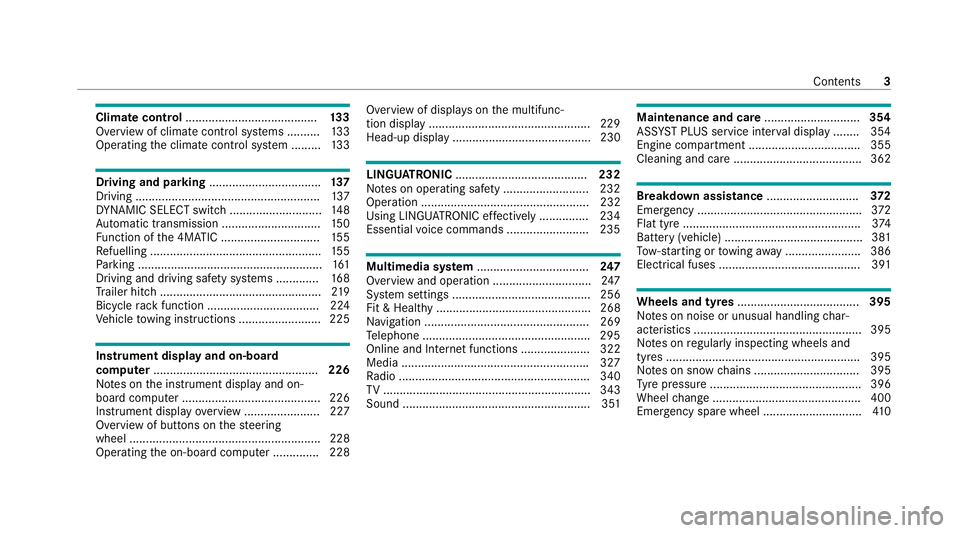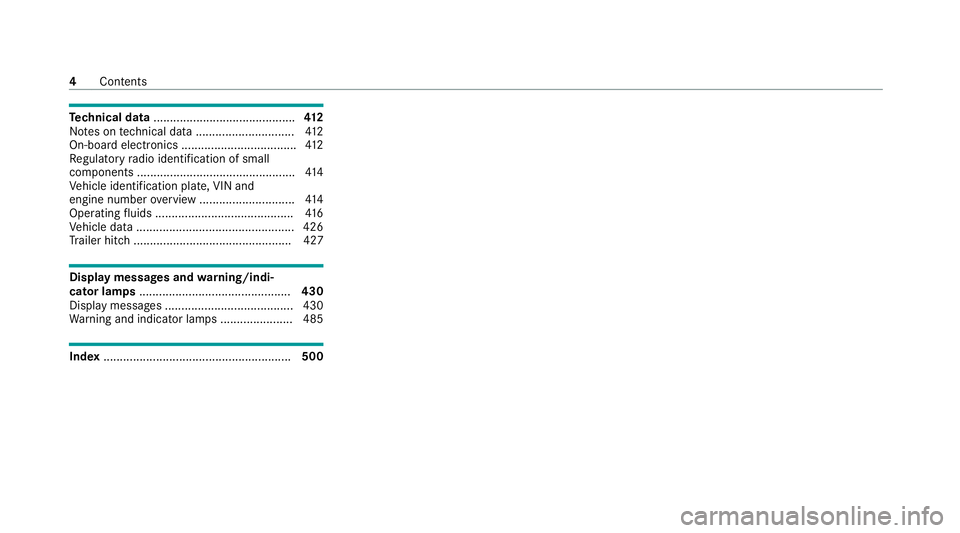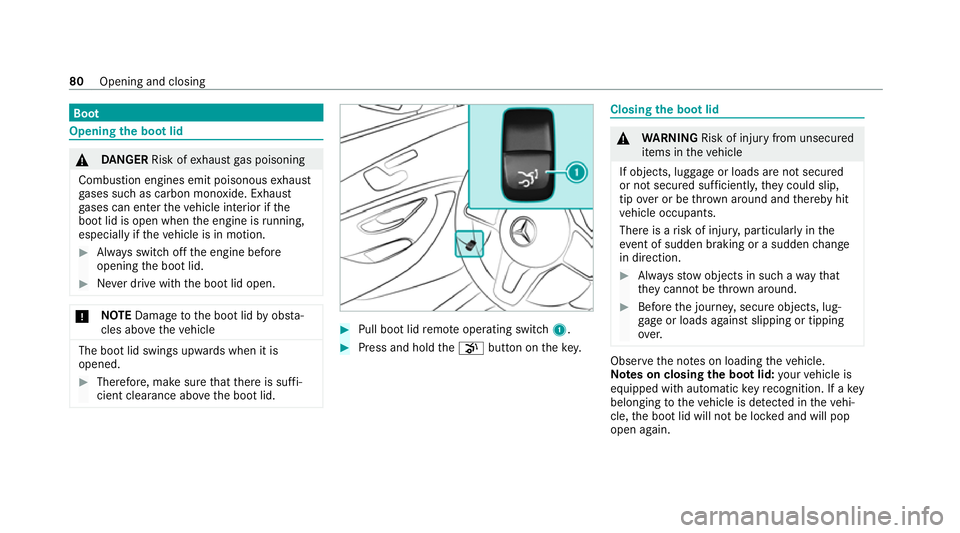engine MERCEDES-BENZ C-CLASS CABRIOLET 2021 Owners Manual
[x] Cancel search | Manufacturer: MERCEDES-BENZ, Model Year: 2021, Model line: C-CLASS CABRIOLET, Model: MERCEDES-BENZ C-CLASS CABRIOLET 2021Pages: 545, PDF Size: 9.48 MB
Page 6 of 545

Climate control
........................................ 13 3
Overview of climate contro l systems ..........1 33
Operating the climate control sy stem ......... 13 3 Driving and pa
rking .................................. 137
Driving ........................................................ 137
DY NA MIC SELECT switch ............................1 48
Au tomatic transmission .............................. 15 0
Fu nction of the 4MATIC .............................. 15 5
Re fuelling .................................................... 15 5
Pa rking ........................................................ 161
Driving and driving sa fety sy stems .............1 68
Tr ailer hit ch................................................. 219
Bicycle rack function .................................. 224
Ve hicle towing instructions ........................ .225 Instrument display and on-board
comp
uter.................................................. 226
No tes on the instrument display and on-
board computer .......................................... 226
Instrument display overview ...................... .227
Overview of buttons on thesteering
wheel ..........................................................2 28
Operating the on-board computer .............. 228 Overview of displa
yson the multifunc‐
tion display .................................................2 29
Head-up display .......................................... 230 LING
UATRONIC ........................................ 232
No tes on operating saf ety .......................... 232
Ope ration ................................................... 232
Using LINGU ATRO NIC ef fectively ............... 234
Essential voice commands ........................ .235 Multimedia sy
stem .................................. 247
Overview and operation .............................. 247
Sy stem settings .......................................... 256
Fit & Healt hy............................................... 268
Na vigation .................................................. 269
Te lephone .................................................. .295
Online and Internet functions ..................... 322
Media ........................................................ .327
Ra dio .......................................................... 340
TV ............................................................... 343
Sound ......................................................... 351 Main
tenance and care ............................. 354
ASS YST PLUS service inter val display ........ 354
Engine compartment .................................. 355
Cleaning and care ...................................... .362 Breakdown assi
stance ............................ 372
Emergency ................................................. .372
Flat tyre ...................................................... 374
Battery (vehicle) .......................................... 381
To w- starting or towing away ....................... 386
Electrical fuses ........................................... 391 Wheels and tyres
..................................... 395
No tes on noise or unusual handling char‐
acteristics .................................................. .395
No tes on regular lyinspecting wheels and
tyres .......................................................... .395
No tes on snow chains ................................ 395
Ty re pressure .............................................. 396
Wheel change ............................................ .400
Emergency spa rewheel .............................. 41 0 Con
tents 3
Page 7 of 545

Te
ch nical data ........................................... 412
No tes on tech nical da ta.............................. 412
On-board electronics ................................... 412
Re gulatory radio identification of small
components ................................................ 414
Ve hicle identification plate, VIN and
engine number overview ............................ .414
Operating fluids .......................................... 416
Ve hicle data ................................................ 426
Tr ailer hit ch................................................ 427 Displ
aymessages and warning/indi‐
cator lamps .............................................. 430
Display messages ...................................... .430
Wa rning and indicator lamps ...................... 485 Index
......................................................... 5004
Contents
Page 14 of 545

1
L Distance warning →
494
2 Ð Powe rst eering →
488
3 #! Turn signal lights →
121
4 ; Engine diagnostics →
489
5 % Diesel engine: preglow
6 ! Electric pa rking brake (red) →
492
7 J Brakes (red) →
492
8 ÿ Coolant temp erature →
489
9 Coolant temp erature display →
227
A J Brakes (yellow) →
492
B ! Electric pa rking brake (yellow) →
492
C ! ABS →
495 D
6 Restra int sy stem →
487
E ü Seat belt →
487
F K High beam →
121
G L Low beam →
11 9
H 8 Reser vefuel with fuel filler flap location
indicator →
489
I Fuel le vel →
227
J T Standing lights →
11 9
K R Rear fog light →
12 0
L h Tyre pressure monitoring sy stem →
498
M å ESP®
OFF →
495
N ÷ ESP®
→
495 At
aglance – Indicator and warning lamps (s tanda rd) 11
Page 16 of 545

1
#! Turn signal lights →
121
2 R Rear fog light →
12 0
3 K High beam →
121
L Low beam →
11 9
T Standing lights →
11 9
4 ÿ Coolant temp erature →
489
5 Coolant temp erature display →
227
6 L Distance warning →
494
7 ü Seat belt →
487
8 h Tyre pressure monitoring sy stem →
498
9 Ù Powe rst eering →
488
A ! Electric pa rking brake (yellow) →
492
B ! Electric parking brake (red) →
492
C 6 Restra int sy stem →
487 D
ï Trailer hit ch →
488
E J Brakes (red) →
492
F 8 Reser vefuel with fuel filler flap location
indicator →
489
G Fuel le vel →
227
H ä Suspension →
494
I J Brakes (yell ow) →
492
J # Electrical fault →
489
K ; Engine diagnostics →
489
L % Diesel engine: preglow
M ! ABS →
495
N å ESP®
OFF →
495
÷ ESP®
→
495 At
aglance – Indicator and warning lamps (widesc reen cockpit) 13
Page 24 of 545

Pr
otection of the environment
+ ENVIRONMENTAL
NOTEEnvironmental
dama gedue tooperating conditions and
personal driving style The pollutant emission of
theve hicle is
directly related tothewa yyo u operate the
ve hicle.
Operate your vehicle in an environmentally
re sponsible manner tohelp pr otect the envi‐
ro nment. Please obser vethefo llowing rec‐
ommendations on ope rating conditions and
pe rsonal driving style.
Operating conditions: #
Make sure that the tyre pressure is cor‐
re ct. #
Do not car ryany unnecessary weight
(e.g. roof luggage rack s once you no
lon ger need them). #
Adhere tothe service inter vals.
A regularly serviced vehicle will contri b‐
ute toenvironmen tal pr otection. #
Alw ays ha vemaintenance workcar ried
out at a qualified specialist workshop.
Pe rsonal driving style: #
Do not depress the accelera tor pedal
when starting the engine. #
Do not warm upthe engine while the
ve hicle is stationar y. #
Drive carefully and maintain a suitable
di st ance from theve hicle in front. #
Avoid frequent, sudden acceleration
and braking. #
Change gear in good time and use each
ge ar on lyup toÔ of its maximum
engine speed. #
Switch off the engine in stationary traf‐
fi c, e.g. byusing the ECO start/ stop
function. #
Drive fuel-ef ficiently. Obser vethe ECO
display for a fuel-ef ficient driving style. Ta
ke -back of end-of-life vehicles
EU countries onl y:
Mercedes-Benz will take back your end-of-life
ve hicle for environment-friendly disposal in
accordance with the European Union(EU) End-
of-Life Vehicles Directive.
A network of vehicle take -ba ckpoints and dis‐
mantlers has been es tablished foryo uto return
yo ur vehicle. You can lea veit at any of these
points free of charge . This makes an impor tant
contribution toclosing there cycling circle and
conse rving resources.
Fo r fur ther information about there cycling and
disposal of end-of-li fevehicles, and theta ke-
back conditions, please visit the national
Mercedes-Benz website foryo ur count ry. Gene
ral no tes 21
Page 31 of 545

Ve
hicle comp onent (designation in
accordance with EU DoC) SA
Rva lue in W/k gA pplicable limitvalue
Ra dio data transmission telephone sys‐
tem < 0.4 W/k
g2 W/kg
Hermes 2. 1< 0.4 W/kg2 W/kg
Compensator ECE DE003 & ECE DE004 < 0.4 W/k g2W/kg
Ta blet PC SM-T230NZ < 0.7 W/kg4 W/kg
DA I RSE <1.8 W/k g4 W/kgJack
Copy and translation of
the original declaration
of confo rmity:
Original CE declaration of conformity
Bosal Hun gary KFT hereby decla resth at
Jack: Daimler jack products
with
serial no.: A 205 580 00 00
A 21 2 580 00 18
A 21 2 580 04 18
A 231 580 00 18 complies wi
th thefo llowing directives:
EU2006/42/EC
The following standard has been obse rved dur‐
ing de velopmen t:EN ISO 12100 This publication pr
ovides authorisation to
inspect (equipment), prepare tech nical docu‐
mentation and pr ovide authentication.
The jack may not be used before all the de tails
ha ve been defined and con firm ed, as described
in the Owner's Manual forth e jac k.Ifth is is not
th e case, the jack may not be used.
[Signature] [Signature]
[Name of signatory]
R&D Manager BHUK [Name of signatory]
Project Engineer28
General no tes
Page 83 of 545

Boot
Opening the bo
otlid &
DANG ER Risk of exhaust gas poisoning
Combustion engines emit poisonous exhaust
ga ses such as carbon monoxide. Exhaust
ga ses can enter theve hicle interior if the
boot lid is open when the engine is running,
especially if theve hicle is in motion. #
Alw ays switch off the engine before
opening the boot lid. #
Never drive with the boot lid open. *
NO
TEDama getothe boot lid byobs ta‐
cles ab ovetheve hicle The boot lid swings upwards when it is
opened. #
Therefore, make sure that there is suf fi‐
cient clearance ab ovethe boot lid. #
Pull boot lid remo teoperating switch 1. #
Press and hold thep button on thekey. Closing
the boot lid &
WARNING Risk of inju ryfrom unsecu red
items in theve hicle
If objects, luggage or loads are not secured
or not secured suf ficientl y,they could slip,
tip ove r or be throw n around and thereby hit
ve hicle occupants.
There is a risk of injur y,particularly in the
ev ent of sudden braking or a sudden change
in direction. #
Alw aysstow objects in such a wayth at
th ey cannot be thro wn around. #
Before the journe y,secure objects, lug‐
ga ge or loads against slipping or tipping
ove r. Obser
vethe no tes on loading theve hicle.
Note s on closing the boot lid: your vehicle is
equipped with automatic keyre cognition. If a key
belonging totheve hicle is de tected in theve hi‐
cle, the boot lid will not be loc ked and will pop
open again. 80
Opening and closing
Page 88 of 545

#
Switch on the ignition. #
Toactivate: pull button 1.
AIR CAP will extend and the indicator lamp on
button 1will light up. #
Todeactivate: press button 1.
AIR CAP will retract and the indicator lamp on
button 1will go out. If
th eve hicle is par ked with the soft top open
and the ignition is switched off, AIR CAP will
re tract au tomatical ly.
When youre start the engine af ter having been
par ked, AIR CAP will extend again au tomatically. Fi
tting and removing the folding draught
stop &
WARNING Risk of accident when using
th e draught stop in poor visibility condi‐
tions
The draught stop impairs your view tothe
re ar. #
Use the draught stop only in good visi‐
bility conditions. &
WARNING Risk of accident and inju ry
due toan incor rectly fitted draught stop
The draught stop may become loose while
yo u are driving and endan gerot her road
users. #
Fitthe draught stop as described. #
Do not place any objects on thefitted
draught stop. *
NO
TEThe draught stop can be damaged
if fitted when the soft top is closed The
vehicle interior or the draught stop can
be damaged if fitted when the soft top
closed. #
Tofit, open the soft top. *
NO
TEDama getothe draught stop due
to collision wi thseat backrests The draught
stop may collide with the front
seat backrests when fitted. #
Adjust the backrest positions of the
front seats. The
folding draught stop is fitted overth ere ar
seats toprotect against wind when you are driv‐
ing with the soft top open. Only the front seats
can be occupied when thefo lding draught stop
is fitted. Opening and closing
85
Page 90 of 545

Pe
rform thefo llowing steps in sequence on bo th
sides of theve hicle: #
Pull handle 5inthe direction of the ar row. #
Align folding draught stop 1 with side fix‐
ture 4ontheve hicle from abo veand insert. #
Push handle 5onfolding draught stop 1
back as far as it will go.
Fo lding draught stop 1 is loc ked. Fo
llow the instructions in reve rse order to
re mo vethefo lding draught stop. Problems with
the soft top The so
fttop will not open or close.
Po ssible causes:
R The ignition is not switched on. #
Make sure that the ignition is switched on.
R The brake pedal is not depressed with the
ve hicle stationar y. #
Dep ress the brake pedal.
R The on-board electrical sy stem voltage is too
lo w. #
Start the engine.
R The boot separator is not closed. #
Remo ve ov erhanging luggage and close the
boot separator.
R The boot lid is open. #
Close the boot lid (/ page 80). R
The soft top has been opened and closed
se veral times in a row. The soft top drive has
been switched off automatically and will be
av ailable again af ter appro ximately ten
minutes. #
Repeat the opening or closing procedure
af te r appro ximately ten minu tes.
R You are driving at a speed greaterth an
60 km/h. #
Reduce your speed tobelow 60 km/h.
R The soft top mechanical components or con‐
trol sy stem are defective. #
Consult a qualified specialist workshop. Opening and closing
87
Page 98 of 545

Note
s onthe cor rect driver's seat position &
WARNING Risk of inju ryifve hicle set‐
tings are adjus ted while theve hicle is in
motion
Yo u could lose cont rol of theve hicle in par‐
ticular in thefo llowing situations:
R Ifyo u adjust the driver's seat, the head
re stra ints, thesteering wheel or the mir‐
ro r while theve hicle is in motion.
R Ifyo ufast enyour seat belt while theve hi‐
cle is in motion. #
Before starting the engine: adjust the
driver's seat, head restra ints, steering
wheel and mir ror in particular and fas‐
te nyo ur seat belt. Ensure
thefo llowing when adjusting steering
wheel 1, seat belt 2and driver's seat 3:
R You are sitting as faraw ay from the driver's
airbag as possible, taking thefo llowing
points into consideration:
R You are sitting in an upright position
R Your thighs are slight lysuppor tedby the seat
cushion R
Your legs are not fully extended and you can
depress the pedals properly
R The back of your head is suppo rted at eye
le ve lby the cent reofthe head restra int
R You can hold thesteering wheel with your
arms slightly bent
R You can mo veyour legs freely
R You can see all the displa yson the instru‐
ment clus ter clea rly
R You ha vea good overview of the tra ffic con‐
ditions
R Your seat belt sits snug lyagainst your body
and passes across the cent reofyour shoul‐
der and across your hips in the pelvic area Seats and
stowing 95